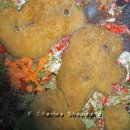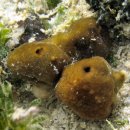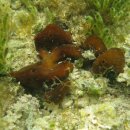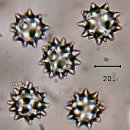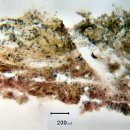Chondrilla caribensis Ruetzler, Duran & Piantoni (2007)
Chondrosida, Chondrillidae
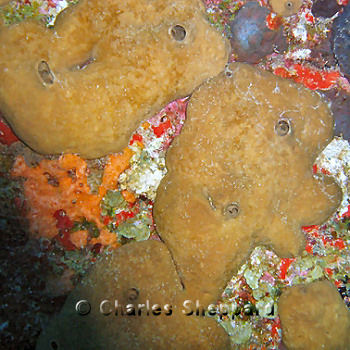
| Common Name(s): |
Chicken liver sponge |
| Growth Form: |
Thick encrusting lumps, pillows, low mounds, sheets, runners or any combination. |
| Surface: |
Smooth, slippery, shiny. |
| Color: |
Yellow brown and greenish brown to dark brown, often with paler sides; cryptic specimens may be completely pale whitish or tan. Internal color cream. |
| Consistency: |
Tough, difficult to tear. |
| Exudate: |
None. |
| Oscules: |
Small, flush or indented, with a collar that may be elevated or indented; scattered or on top of pillows or mounds. |
| Skeletal Components (Spicules, Fibers): |
No megascleres or spongin fibers. Microscleres are spheres with very short rays (spheraster) about 20-25 μm across. |
| Skeletal Architecture: |
Spherasters concentrated in the surface and along internal canals, and scattered throughout the rest of the body. |
| Ecology: |
Found in shallow hard bottoms, lagoons, caves and tidal channels. Often attaches to seagrass blades, dead finger coral branches, mangrove prop roots and artificial structures. |
| Distribution: |
Bermuda, South Florida, Bahamas, Caribbean in 0.5-5 m. |
| Notes: |
The sponge described here is Chondrilla caribensis form caribensis. Chondrilla caribensis form hermatypica Ruetzler, Duran & Piantoni (2007) is thinly encrusting and lives on reefs, often overgrowing live corals. Chondrosia collectrix (Schmidt, 1870) is closely similar in shape and consistency, but is shiny black and lacks spicules. |
| References: |
Schmidt (1870), Ruetzler (1986), Ruetzler et al. (2007). |
| Similar species: |

Cliona varians |
|
|

